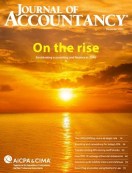Estates and nongrantor trusts must file income tax returns just as individuals do, but with some important differences. For one, their income is taxed at either the entity or beneficiary level depending on whether it is allocated to principal or allocated to distributable income, and whether it is distributed to
Personal financial planning
AICPA Establishes PFP Conference Scholarship
The Institute has established the P. Thomas Austin Personal Financial Planning Division Scholarship in honor of the CPA who has chaired the Advanced Estate Planning Conference for three decades. The scholarship will cover the registration fee and travel expenses of a young CPA to attend the conference each year beginning
AICPA Urges Lawmakers to Ban Tax Patents
The AICPA joined a group of national consumer and taxpayer organizations to urge Congress to ban tax strategy patents before adjourning for the year. In a letter to lawmakers, the groups said that tax strategy patents effectively create a monopoly for patent holders on certain parts of the U.S. tax
New Life for Charitable Lids
One common estate planning technique the IRS has opposed or blocked for years is “charitable lid planning.” This technique relies on “defined value” and “value adjustment” clauses or similar provisions in wills, deeds or other transfer documents to cap the transfer taxes on estates, gifts or generation-skipping trusts at some
Advice to Clients in Uncertain Markets
In the “flash crash” on May 6, 2010, the Dow Jones Industrial Average dropped nearly 1,000 points only to recover more than 600 points by the market close. On the heels of the financial crisis of 2008, this incident only exacerbated investors’ concerns. Some strategies to manage volatility risk that
Maximizing the Section 199 Deduction
Every business in the manufacturing sector, whether small or large, should consider the manufacturing deduction under IRC § 199. While section 199 comes with a complex set of rules, it nonetheless represents a valuable tax break for businesses that perform domestic manufacturing and certain other production activities. However, businesses should
Where Do Investors Prefer to Find Nonfinancial Information?
It’s no secret to investors that annual reports filed by U.S. companies are becoming increasingly complex. Many reports in the business press over the past decade cite concern that the proliferation of required disclosures accompanying financial reports makes it difficult to decipher a company’s performance and identify factors that drive
Reverse Mortgage Guidance Issued
Bank, thrifts and credit unions received a new framework for providing clear and balanced information to consumers about the risks and benefits of reverse mortgages under final guidance issued by the Federal Financial Institutions Examination Council (FFIEC). The guidance is of importance to CPAs who may consider reverse mortgages as
The Foreign Account Tax Compliance Act
A key component of the federal government’s push for heightened tax compliance among U.S. taxpayers with foreign accounts and assets is the Foreign Account Tax Compliance Act (FATCA). In an interview in February this year with the JofA, IRS Commissioner Doug Shulman called the then-pending legislation “the next big thing”
Roth IRA Conversion Quiz
By now, CPAs have heard much about Roth IRA conversions made widely available in 2010. Take the following test to see how much you’ve learned. TRUE OR FALSE? 1. Starting in 2010, there are no income limitations to make regular contributions to a Roth IRA. 2. Roth IRA investment income
Discharging Taxes in Bankruptcy
With the downturn in the economy and massive job losses, personal bankruptcy filings have exploded. According to the National Bankruptcy Research Center, approximately 1.4 million bankruptcies were filed in 2009, a 32% increase over 2008. They included Chapter 7 bankruptcy filings, which increased 42%, and Chapter 13 filings, which increased
Regular IRA to Roth IRA Conversion: Evaluating the Income Recognition Options
Editor’s note: Also read “Deferral and Spreading of Roth Conversion Income Not Always Best,” in the July 2010 issue of the Journal of Accountancy. Click here to download “Regular IRA to Roth IRA Conversion: Evaluating the Income Recognition Options,” an illustrative spreadsheet that allows planners to choose between two possible
EIN Retention When Converting a Corporation to an LLC
Most companies that convert a corporation to an LLC want the LLC to retain the historic employer identification number (EIN) of the corporation and may assume that the EIN carries over automatically to the LLC. In fact, the IRS will reassign the historic EIN of a corporation to a successor
Charitable Planning: CRTs, CLTs and the Increasing Payment CLAT
One of the main reasons people give to charity is for their ego or image—they want to be seen in the community as philanthropic. Another main reason some donate is for the tax breaks. Others give to charity for truly altruistic reasons. Yet others leave money to charity because they
Closing Up Shop: How to Successfully Shut Down a Private Foundation
The precipitous drop in wealth in the United States during the 2008–2009 financial meltdown accelerated a trend of many private foundations’ considering closing their doors. Foundations gave 8.4% less in grants in 2009 from the year before, as the value of their assets fell by 17.2%. Between 2007 and 2008,
Valuing Art for Tax Purposes
Even people who don’t collect art probably own a painting or sculpture or two. At some point, one of two things is likely to happen: One, the artwork will be given away, perhaps as a noncash charitable contribution for which the owner will claim an itemized deduction, or as a
Deferral and Spreading of Roth Conversion Income Not Always Best
This year has been touted as the Year of the Roth IRA Conversion (“2010: The Year of the Roth Conversion?” JofA, Jan. 2010, page 28). Advice abounds on when to carry out a conversion and how to pay for it. Often, though, a thorough analysis of the alternatives requires planners
Don’t Neglect to Elect
A wide range of federal tax elections gives individual taxpayers options for how they report certain income or expense items. Some of the more common elections for individuals concern retirement plans, medical expenses and interest expense. Each election has specific rules as to who can make the election, when and
Gamel Wins PFP Distinguished Service Award
Beth C. Gamel is the recipient of the Institute’s 2009 Personal Financial Planning Distinguished Service Award. The award recognizes an AICPA volunteer who significantly contributes to the advancement of personal financial planning as a practice discipline and exemplifies the CPA as financial planner. Co-founder and executive vice president of Pillar
Survey Offers Glimpse at How Americans are Tightening Belts
Citing unemployment, financial emergencies and credit card debt, 54% of respondents in a recent poll reported being unable to save money over the past 12 months, while 46% of respondents had managed to put some money away. Among Americans who were able to save money over the past year, most
Features
SPONSORED REPORT
Preparing clients for new provisions next tax season
As the 2025 filing season approaches, H.R. 1 introduces significant tax reforms that CPAs must be prepared to navigate. These legislative changes represent some of the most comprehensive tax updates in recent years, affecting both individual and corporate taxpayers. This report provides in-depth analysis and guidance on H.R. 1.



















